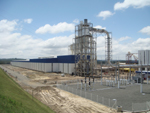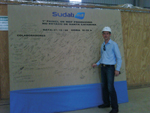Sudati is first in MDF
7 April 2009In December 2008, Brazilian plywood manufacturer Sudati plywood industry ltda became the first producer of MDF in the state of Santa Catarina
Sudati is headquartered in the city of Palmas in the state of Paraná, where it says there is excellent soil for agricultural production, a mild
climate, and where it can call on
professionals who are European descendants, such as Germans, Italians, Poles and Ukrainians.
Palmas is situated 1,300 metres above sea level and has more than 40 thousand inhabitants. It is apparently known for its cold weather – and for having one of the first wind turbine plants in Brazil.
Sudati plywood industry ltda started its activities in January 1998 and says it has today positioned itself as one of the most important industries in the forestry-based sector in Brazil, with four plywood manufacturing subsidiaries in the © p66 ß p65 states of Paraná and Santa Catarina. The group targets its plywood production on the export market and claims it is a pioneer in Brazil in the manufacture of pinus elliottis plywood.
“Performance on the export market demands intensive efforts to maintain the patterns of quality in each market. In administrative procedures, Sudati obtained ISO9001-2000 certification in 2005,says the company.
To ensure that its products adhere to international rules, Sudati says it maintains modern factories and advanced quality control systems, with laboratory tests in all production units. The production process is focused on quality control with external examinations made by BVQI. It also has the support of TECO (united states) and European CE-certified companies.
Sudati has its own considerable forestry stock, besides having formed various partnerships in the form of technological cooperation and supply of seedlings for small producers who can then use their land more efficiently and thus secure raw material supplies for the future.
The company is beginning the process of certifying its own forests and says it puts strong emphasis on meeting relevant environmental standards.
Today, Sudati claims it is one of the 10 largest plywood producers in the world, with a capacity of 500,000m3/year on four lines. Its plywood production consumes around 650,000 tonnes of pine logs annually.
The group exports approximately 85% of production and claims it is responsible for around 30% of plywood exports from Brazil.
Approximately 97% of the exported production is destined for Asia, Africa, the Americas, Europe, the Middle East, Australia and the Caribbean.
The highest plywood production figure achieved by Sudati was 47,000m3/month, but in march this year it was nearer 30,000m3, according to Fabiano Sangali, sales director of the Sudati Group.
“The current global economic climate is affecting our export business very badly and we are mostly an export-based company, particularly for our plywood,said Mr Sangali. “We are facing a challenge just to keep our market share and we are attaching importance to little things which before we did not see.”
On December 27th 2008, Sudati entered a new phase in its 10th anniversary year by inaugurating its first MDF line at Otacílio Costa in Santa Catarina state.
With a target capacity of 220,000m3 a year of MDF, the line will bring Sudati’s total annual wood consumption close to one million cubic metres, according to Luiz Alberto Sudati, chairman of the group.
The MDF project began in April 2006 to meet the perceived demand in the domestic market for additional MDF capacity, mainly for furniture production, and counter-balancing the company’s reliance on export markets for its plywood.
Purchase of the equipment for the new MDF line was
completed in January 2007 and the company then set about choosing an exact location for the new mill.
“The support of local government in the person of mayor Altamir Paes and of the state in the person of governor Luiz Henrique, as well as logistics in the area, were crucial in the choice of Otacílio Costa,said Mr Sudati.
The new factory site has a gross area of 300,000m2, with 120,000m2 of that devoted to production facilities.
To bring the project to full realisation, Sudati employed the services of Carlos A Buest as industrial director and chief
engineer of the MDF plant – a man with over 35 years’ experience in the panel industry.
Mr Buest’s “innovativechoice of equipment for the new mill led to a panel which “exceeded our expectations,in his own words.
Investment in the MDF factory was Real80m.
Initially at least, the line is producing raw, uncoated MDF in 2750x1850mm panels and standard quality. However, light and extra-light panels are planned for the future as the company sets its sights on the domestic furniture manufacturing market.
“We propose to reposition our brand and to transfer our international efforts into the internal market, too,said Mr Sangali.
Logistics involve road, rail and sea transport. “We want to achieve flexibility and low cost for both close and distant
customers,added MDF sales director Claudio Prospero.
“Today Sudati presents itself as a new option for both the
retail market and the Brazilian and international furniture industries.”
The MDF line
Shanghai Wood Based Panel Machinery Co Ltd (SWPM) of Shanghai, China, was responsible for the supply of equipment from the chip preparation area to fibre preparation, mat forming and pressing and board
trimming up to sanding.
It was also responsible for the pneumatic transfer system, electronic controls, the hydraulic systems and the laboratory
equipment.
The pressurised refiner system was supplied by Andritz, including the plug screw feeder, and this was a contract made directly between Andritz and Sudati.
The sander was also a direct supply
contract, with Steinemann.
The main hot press is a 12-daylight unit with a width of 6ft and length of 18ft. The hot platen size is in fact 2.38x5.70m and the platens themselves are 130mm thick. It has a total pressing force of around 40,000KN, according to SWPM, and a maximum specific pressure of 3.7MPa.
The press is heated by thermal oil and SWPM was also responsible for the supply and erection of the energy plant, which supplies energy for refining, pressing, glue and wax preparation and the drying system.
The energy system is fuelled by waste material generated during the process (mainly board trim and sanding dust).
Board density of the finished product is in the range of 650-950kg/m3 and finished board thickness is eight to 22mm.
Raw material is 100% pine wood, including veneer waste from the plywood operations.

